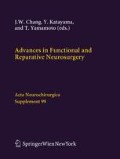Summary
Deep brain stimulation (DBS) of the thalamus (Vo/Vim) has become popular as a means of controlling involuntary movements, including post-stroke movement disorders. We have also found that post-stroke movement disorders and motor weakness can sometimes be controlled by motor cortex stimulation (MCS). In some forms of movement disorders, motor dysfunction becomes evident only when patients intend to move their body. We have developed an on-demand type stimulation system which triggers stimulation by detecting intrinsic signals of intention to move. Such a system represents feed-forward control (FFC) of involuntary movements. We report here our experience of DBS and MCS for controlling post-stroke movement disorders, and discuss the value of FFC. Excellent control of post-stroke movement disorders was achieved by conventional DBS and/or MCS in 20 of 28 patients with hemichoreoathetosis, hemiballism tremor, and motor weakness. FFC was tested in 6 patients who demonstrated excellent control of post-stroke postural tremor or motor weakness by conventional DBS or MCS. The on-demand stimulation provided satisfactory FFC in 4 of 4 patients with postural tremor and 2 of 2 patients with motor weakness, when the activity of muscles involved in posturing or intention to move was fed into the system. These findings justify further clinical studies on DBS and MCS in patients with post-stroke movement disorders. The on-demand type stimulation system may also be useful for overcoming various post-stroke movement disorders.
Access this chapter
Tax calculation will be finalised at checkout
Purchases are for personal use only
References
Fields H, Adams JE (1974) Pain after cortical injury relieved by electrical stimulation of the internal capsule. Brain 97: 169–178
Franzini A, Ferroli P, Dones I et al (2003) Chronic motor cortex stimulation for movement disorders. A promising perspective. Neurol Res 25: 123–126
Katayama Y, Fukaya C, Yamamoto T (1998) Post-stroke pain control by chronic motor cortex stimulation: neurological characteristics predicting favorable response. J neurosurg 89: 585–591
Katayama Y, Kasai M, Oshima H et al (2001) Subthalamic nucleus stimulation in Parkinson’s disease. Benefits observed in levodopa-intolerant patients. J Neurosurg 95: 213–221
Katayama Y, Oshima H, Fukaya T et al (2001) Control of post-stroke movement disorders using chronic motor cortex stimulation. Acta Neurochir [Suppl] 79: 89–92
Katayama Y, Yamamoto T, Kobayashi K, Oshima H, Fukaya C (2003) Deep brain and motor cortex stimulation for post-stroke movement disorders and post-stroke pain. Acta Neurochir [Suppl] 87: 121–124
Tsubokawa T, Katayama Y, Yamamoto T (1995) Control of persistent hemiballismus by chronic thalamic stimulation. J Neurosurg 82: 501–505
Tsubokawa T, Katayama Y, Yamamoto T et al (1993) Chronic motor cortex stimulation in patients with thalamic pain. J Neurosurg 78: 393–401
Woolsey CN, Erickson T, Gilson WE (1979) Localization in somatic sensory and motor areas of human cerebral cortex as determined by direct recording of evoked potentials and electrical stimulation. J Neurosurg 51: 476–506
Yamamoto T, Katayama Y, Fukaya C et al (2001) New method of deep brain stimulation therapy using two electrodes implanted in parallel and side by side. J Neurosurg 95: 1075–1078
Yamamoto T, Katayama Y, Kobayashi K et al (2003) Dual-floor burr hole adjusted to burr-hole ring and cap for implantation of stimulation electrode. J Neurosurg 99: 783–784
Yamamoto T, Katayama Y, Kano T et al (2004) Deep brain stimulation for the treatment of parkinsonian, essential, and post-stroke tremor. A suitable stimulation method and changes in effective stimulation intensity. J Neurosurg 101: 201–209
Author information
Authors and Affiliations
Corresponding author
Editor information
Editors and Affiliations
Rights and permissions
Copyright information
© 2006 Springer-Verlag
About this chapter
Cite this chapter
Katayama, Y., Kano, T., Kobayashi, K., Oshima, H., Fukaya, C., Yamamoto, T. (2006). Feed-forward control of post-stroke movement disorders by on-demand type stimulation of the thalamus and motor cortex. In: Chang, J.W., Katayama, Y., Yamamoto, T. (eds) Advances in Functional and Reparative Neurosurgery. Acta Neurochirurgica Supplementum, vol 99. Springer, Vienna. https://doi.org/10.1007/978-3-211-35205-2_3
Download citation
DOI: https://doi.org/10.1007/978-3-211-35205-2_3
Publisher Name: Springer, Vienna
Print ISBN: 978-3-211-35204-5
Online ISBN: 978-3-211-35205-2
eBook Packages: MedicineMedicine (R0)

